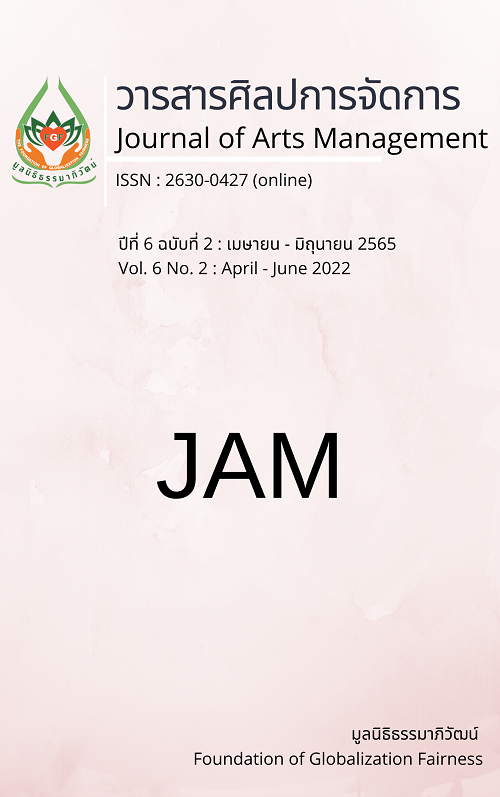การพัฒนารูปแบบการบริหารจัดการการท่องเที่ยวเชิงอนุรักษ์ของชุมชนในยุคดิจิทัล
Main Article Content
บทคัดย่อ
บทความวิจัยนี้มีวัตถุประสงค์เพื่อ 1) ศึกษาองค์ประกอบการบริหารจัดการการท่องเที่ยวเชิงอนุรักษ์ของชุมชนในยุคดิจิทัล 2) พัฒนารูปแบบการบริหารจัดการการท่องเที่ยวเชิงอนุรักษ์ของชุมชนในยุคดิจิทัล การวิจัยนี้เป็นการวิจัยแบบผสมผสานระหว่างการวิจัยเชิงคุณภาพและเชิงปริมาณ เครื่องมือที่ใช้ในการศึกษาเชิงคุณภาพได้แก่ การสัมภาษณ์เชิงลึกผู้เชี่ยวชาญกับการประชุมสนทนากลุ่มผู้ทรงคุณวุฒิ และทำการวิเคราะห์เชิงเนื้อหา เครื่องมือที่ใช้ในการศึกษาเชิงปริมาณ ได้แก่ แบบ สอบถาม จำนวน 400 ชุด กลุ่มตัวอย่างประกอบด้วย ผู้จัดการแหล่งท่องเที่ยวเชิงอนุรักษ์ ผู้นำชุมชนและบุคลากรภาครัฐที่เกี่ยวข้อง สถิติที่ใช้ในการวิจัย ได้แก่ ความถี่ ค่าร้อยละ ค่าเฉลี่ย ค่าเบี่ยงเบนมาตรฐาน และการวิเคราะห์องค์ประกอบเชิงสำรวจ ผลการวิจัยพบ 7 องค์ประกอบที่สำคัญ สำหรับการบริหารจัดการการท่องเที่ยวเชิงอนุรักษ์ของชุมชนในยุคดิจิทัล ประกอบด้วย การจัดการภาครัฐ การมีส่วนร่วมของชุมชน การนำชุมชนเพื่อการท่องเที่ยว การจัดระบบสาธารณะของแหล่งแหล่งท่องเที่ยว การจัดการความรู้ การอนุรักษ์ทรัพยากร และการประเมินผลเพื่อความยั่งยืน สำหรับผลการพัฒนารูปแบบการบริหารจัดการการท่องเที่ยวเชิงอนุรักษ์ของชุมชนในยุคดิจิทัล คือ SELF Model ประกอบด้วย อัตลักษณ์แหล่งท่องเที่ยวของชุมชน (Signature) การอนุรักษ์ทรัพยากร (Environment) คุณลักษณะและพฤติกรรมชุมชน (Life Style) และสิ่งอำนวยความสะดวกและเทคโนโลยีในชุมชน (Facility) ซึ่งได้รับความเห็นชอบจากผู้ทรงคุณวุฒิด้วยมติเอกฉันท์
Article Details

อนุญาตภายใต้เงื่อนไข Creative Commons Attribution-NonCommercial-NoDerivatives 4.0 International License.
ทัศนะและความคิดเห็นที่ปรากฏในบทความในวารสารศิลปการจัดการ ถือเป็นความรับผิดชอบของผู้เขียนบทความนั้น และไม่ถือเป็นทัศนะและความรับผิดชอบของกองบรรณาธิการ ยินยอมว่าบทความเป็นลิขสิทธิ์ของวารสารศิลปการจัดการ
เอกสารอ้างอิง
Ajana, A. (2004). The conservation tourism business management in Samut Songkhram Province[Master’s Thesis, Chiang Mai University].
Batinic, I. (2015). Role and importance of internet marketing in modern hotel industry. Journal of Process Management – New Technologies, International, 3(3), 34-38.
Benjawan, S., & Chatcahi, S. (2017). A Tourism Management Model by Community of Nangpaya District. Academic Journal Uttaradit University, 12(2), 53-65.
Boo, E. (1991). Ecotourism: The potentials and pitfalls. World Wildlife Fund.
Boonlert, C. (2005). Sustainable tourism development. Press & Design.
Bundit, C. (2018). Evaluation of tourism promotion measures for Thai economic expansion. Journal of International Thai Tourism, 13(2), 91-106.
Ceballos-Lascurain, H., (1991). Tourism, eco-tourism and protected areas. In Kusler, (ed.) Ecotourism and Resource Conservation. Vol. 1. Eco-tourism and resource conservation project.
Department of Tourism. (2018, August). Creative Tourism Management Guide. http://www.trdnrru.net/img/poster1/project01.pdf
Eber, S. (1992). Beyond the green horizon: Principle for sustainable tourism. World Wide Fund for Nature, United Kingdom.
Ester, R.J. (1993). Toward sustainable development: From theory to praxis. Social Development Issues.
Fayol, H. (1949). General and industrial management. Sir Isaac Pitman & Sons.
Ceballos-Lascurain, H. (1990). The landscapes of tourism. The University of Kansas.
Itthipol, K. (2010). Eco-Tourism: A case study of Bann Wang Nam Mok, Nongkhai Province. The Office of The National Cultural Commission Ministry of Culture.
Jinyawee, K. (2011). Communication and social change. Chulalongkorn University.
Kaiser, H.F., & Rice, J. (1974). Little Jiffy, Mark Iv. Educational and Psychological Measurement, 34, 111-117.
Komlak, S. (2014). People’s participation in conservation tourism management: A case study of Wat Takien floating market, Bangkruay District, Nonthaburi Province[Master’s Thesis, Dhurakij Pundit University].
Mallika, T. (2001). Modern management. Expernet.
Ministry of Tourism and Sport. (2018, August). Developing the potential of the tourism industry with statistical data. https://www.mots.go.th/News-view.php?nid=10557
National Tourism Policy Board. (2016, August). Criteria for The Development of Community-Based Tourism in Thailand. https://data.go.th//dataset/bcbd804e-aea8-4d8c-aa72-f87d431d22c6/resource/d4103ef8-e7b6-4540-9c31-d921a8099b8f/download/x-.pdf
Office of the National Economic and Social Development Council. (2004). Handbook of Sustainable Development Indicators in Thailand. Office of the National Economic and Social Development Council.
Orathai, N. (2017). Community participation in management of aquatic animals protected area: A case study of Moo 1, Pa-khad Sub-District, Singhanakhon District, Songkhla Province[Master’s Thesis, Songkla University].
Sasicha, M. (2019, June 17). Community-based tourism for sustainability.
https://www.gsbresearch.or.th/wp-content/uploads/2019/10/GR_report_travel_detail.pdf
Sinlaparu, T. (2007). Research and statistical analysis with SPSS (7th ed.). V. Inter.
Sompob, S. (2009). The appropriate eco-tourism management of Bann Si Na Phan, Ruang Sub-District, Muang District, Nan Province[Master’s Thesis, Maejo University].
Teeradetch, J. (2017). the role of community in environmental management; cased study of Sa-Nguankam Community, Khwaeng Nong Khang Phlu, Nong Kheam District, Bangkok[Master’s Independent Study Thammasat University].
Thailand Institute Scientific and Technological Research. (1997). Policies ecotourism. Thailand Institute Scientific and Technological Research.
Therdchai, C. (2007). The explosive growth of ASEAN-Based tourism: An implication on the future of Thai tourism. The Thailand Research Fund.
Wachirayan, W. (2008). Ecotourism management of Chiang Mai night safari[Master’s Thesis, Chiang Mai University].
Wareeporn, C. (2017). Guidelines for the management of the group, the 5-star OTOP products cages to enter the Asian market: Case by Ban Hua Din Nuea Moo 8 in Chana District, Songkla Province. Modern Management Journal, 15(2), 45-55.
Wichian, W. (2006). Organization behavior (3th ed.). Theerafilm & Scitax.


